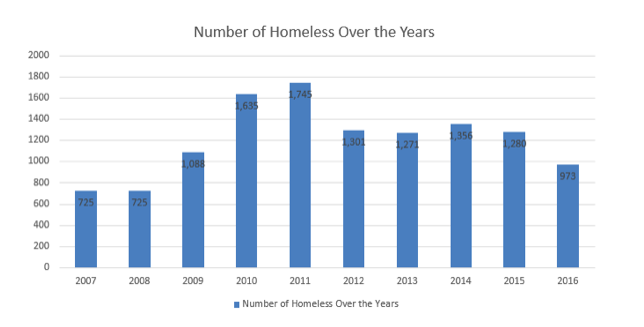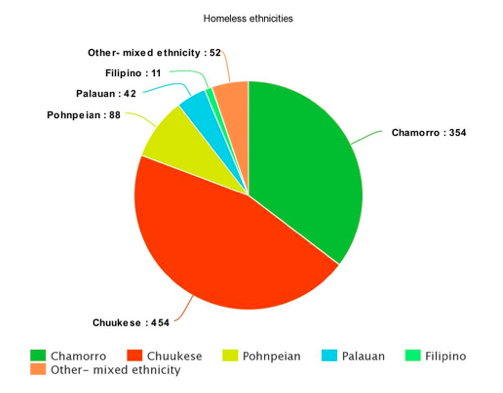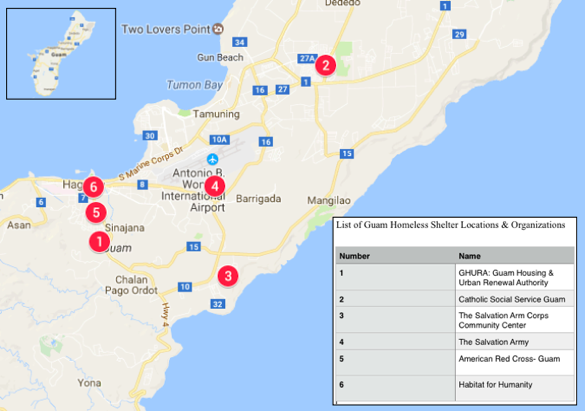The island’s residents should work together to raise awareness of the homelessness issue and take action to effectively minimize it.
The Guam Homeless Point- In-Time count consists of data of the annual total number of homelessness people accumulated on the island. Over the years, the count has both risen and dropped significantly.
According to the results of the 2016 Guam Homeless Point- In- Time final count, the number of homeless people on Guam had decreased by 18% since 2015. Organizations such as the Guam Housing & Urban Renewal Authority (GHURA), Guam Homeless Coalition and the University of Guam School of Nursing have all contributed to the data acquired regarding the number of homeless spotted on the island.
As shown on the bar graph, there were a total of 973 unsheltered homeless persons in 2016 who reside in private or public places such as a car, bus stops, and abandoned buildings. All locations are not suitable for residence.
On the other hand, there are about 112 persons living in emergency shelters and transitional housing programs. At the time of writing this, the 2017 Guam Homeless Point- in- time count has not yet been released.

From 2007 to 2016, there have been both declines and increases in the number of homeless people on Guam.
GHURA along with other partner organizations continuously work to mitigate the homelessness issue in the hopes to eliminating as much as possible.
Included in the count were different ethnic groups and the amount of homeless people. As the count indicates, Chuukese (454) and Chamorro (354) ranked the highest ethnic groups among the rest as shown in the graph below.

To provide further insight to this issue, I took it upon myself to interview Amor Say, an A.D.A. Representative and planner of GHURA. She has been an active member of the organization since 2003 and was able to provide us with current data and insight to her opinions regarding the homelessness issue on Guam.
“We try to help those on the streets, especially families who have been homeless for many years,” she said.
GHURA’s primary goal is to assist and provide funding to low-income renters and homeowners in obtaining suitable housing, and to eliminate homelessness gradually by developing new communities. GHURA is also in partnership with other organizations such as the Guam Homelessness Coalition, Sanctuary, Salvation Army, and many more. On Jan. 29 of 2016, there were over 200 volunteers that assisted in the island’s homeless population count. The homeless count on Guam consists of singles, families, and those suffering from mental illnesses and disabilities.
“Our outreach team goes around Guam in search of any homeless person in need. We spread the word to other organizations, however, not everyone wants to be helped,” Amor states.
GHURA prioritizes assistance for those with families and disabilities. Singles, however, have a tougher time being assisted as they would find ways to work around the system and even leave their homes to beg on the streets again.
Amor explains various instances in which some homeless would abuse their privilege of having a roof over their heads. She shares a particular instance where there was once a family consisting of a mother and her two daughters who were granted a shelter but refused it simply because the mother felt it was rather safer for her children to sleep out on the streets than in a new, unknown home.
From that point on, Amor knew it would take a lot more efforts than just providing houses for families in need as they take time transitioning into a particularly new lifestyle that may seem normal for others. Amor shares that it was very difficult for her to trust certain homeless candidates following those instances as some still abuse their privileges by continuously begging on the streets and not taking action to find jobs to better their lives.
There are various actions the community can take to minimize the homelessness issue on Guam. Services provided by the Guam Housing & Urban Renewal Authority (GHURA), Guam Homeless Coalition, and Guam San Jose Homeless Shelter are continuously working to provide enough homes to shelter those in need.
If interested in assisting these organizations, contact information will be provided below.
Solutions for mitigating homelessness on Guam
Last month, we reported on the homelessness issue on Guam and its severity5 towards our island. Although we may not see them everyday, there are actually hundreds of homeless men, women and children on Guam. Homelessness has, in fact, been an ongoing issue on the island which is why it’s important to consider solutions to minimize the issue.
The annual Point in Time Homeless Count for 2017 has yet to be released. Volunteers from various organizations around the island including the University of Guam’s School of Nursing, together with Salvation Army Captain Tom Stambaugh, have contributed to the homeless count.
To take action in minimizing the homelessness issue, the Guam Housing and Urban Renewal Authority (GHURA) has conducted the Emergency Solutions Grant (ESG) Program.
The ESG Program provides funding for outreach programs for homeless persons living on the streets. It improves the quality and number of shelters for both homeless singles and families, it assists the management of shelters, provides services to those in the shelters, grants re-housing, and strives to prevent individuals and families from falling back into the homelessness cycle.
Many of those roaming the streets of Guam deal with the struggles of childcare, unemployment, and homelessness. Included in 2016’s annual homeless count were veterans, victims of domestic violence, and those suffering abuse and mental illnesses.
The count also classifies homeless individuals along different characteristics such as gender, ethnicity, and barriers to employment.
There were more than 200 volunteers for the annual Point in Time Homeless Count who made their way around the island with safety vests, flashlights, and canned goods to assist whomever they could.
The results of 2016’s Point in Time show that there were 900 unsheltered homeless persons, while the rest were staying in public shelters.
There are, of course, language barriers and cultural differences that much of the homeless are facing. However, organizations such as The Salvation Army are continuously working on solving this issue.
GHURA is in partnership with various organizations such as Guma San Jose Catholic Social Services and the Habitat for Humanity.
Although Habitat for Humanity has not been as active as before, GHURA still provides home investment funds and properties towards community development.
I had the opportunity to interview Mrs. Amor Say, A.D.A. representative and planner of GHURA and gather her opinions regarding this issue. Amor shares that there is an outreach team that constantly goes around the island in search for any homeless persons requiring assistance.
“We have a WhatsApp group that if anyone from our team sees a homeless person, they simply just take a picture and message the location and we would go there immediately,” Amor said.
As this has been an effective solution, Amor shares however, that it is very difficult to gain their trust as they feel cautious when taking action towards getting help.
“Sometimes our team would go out there and help the homeless, other times they would just take pictures and send the location because they are afraid of being viewed of as a threat,” Amor states.
It is a very sensitive process that must be handled properly. Amor also shares tragic stories of various families and children suffering on the streets when faced with addiction issues. GHURA and other organizations, however, try their best to minimize this and help as much people as they possibly can.
Along with Amor, Margaret Hattori- Uchima, Ph.D, dean of UOG’s School of Nursing and Health Sciences and current vice chair of the Guam Homeless Coalition, has contributed greatly to the homelessness issue.
“I met Margaret in 2009 as a volunteer and most of her students even after they graduate, still participate in the annual homeless point in time count,” Amor shares.
The University of Guam has been very active in participating, especially with the homeless count.
Students and faculty are advised to take action towards this matter and contribute what they can whether it’d be participating in the annual Homeless Point in Time counts or simply sending messages to GHURA regarding any prominent and serious issues encountered on the streets of the island.
“We’re trying to increase the funding and provide as much housing as we can but we can only do so much,” Amor said. “As far as solutions, I’d say that our organizations continuously work together to assist the homeless in any way we can and advise the community to do so as well.”
Community support is needed.
If you are interested in volunteering, call Angelina Cruz at 300- 1588 to sign up and register for a mandatory training. Donations of canned food and hygiene products are strongly advised as it is rounded up and distributed among those in need. To know more information about the updated homeless count, contact Amor Say of Guam’s Housing and Urban Renewal Authority at 475- 1406. Locations of various homeless shelters and organizations are provided in the image below.


